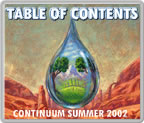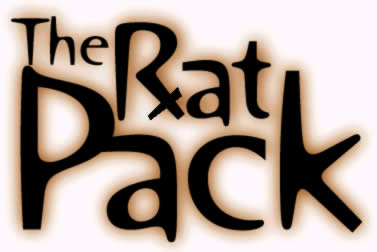|
|
Retiring College of Pharmacy faculty members look back at the creation of a college—and a lasting friendship.
BY SUSAN SAMPLE
Mention “the black crow” to four senior College of Pharmacy
faculty members and all you hear is laughter. “I wasn’t there,
but all of us who sit together at lunch know the story,” says Harold
Wolf PhD’61, professor of pharmacology and toxicology, and manager
of the college’s Anticonvulsant Drug Development Program. “You’ll
have to get Dave to tell you.”
David B. Roll, professor emeritus of medicinal chemistry, finally does—after
he stops laughing—from his office in Washington, D.C., where he is
serving as a congressional fellow for the American Association of Colleges
of Pharmacy (AACP).
“When we were first at the University in the late 1960s,” says
Roll, “Dean [L. David] Hiner was very paternalistic toward his faculty.
There were breakfasts, banquets we had to go to. “One night, we were
at a Rho Chi [pharmacy honor society] banquet at Chuck-A-Rama. No libations,
no nothing. We had a presentation by a woman who’d been on the Good
Ship Hope, a hospital ship, somewhere in India. She came in with about
three carousels of slides.
“She goes on and on. Then she shows us a picture of a crow you couldn’t
see. It was black on black. She must have shown us a half dozen pictures
of what you couldn’t see.”
“We had a hard time hiding our hysteria,” says Arthur D. Broom,
professor of medicinal chemistry, in his version of the story. James W.
Gibb, professor of pharmacology, chuckles even now as he leans back, hands
behind his head, remembering the event in his office in the biomedical
polymers building. “There must have been a black crow in every slide,”
he says.
Now their code word for any tedious event, “the black crow”
is just another humorous memory to the men who, for years, have shared
a table and similar jokes in University Hospital’s cafeteria. But
like any good story, there’s more to this one—just as there’s
more to this group of four.
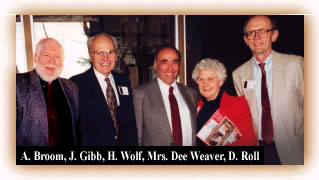 |
“The three you’ve interviewed—Art, Jim, and Dave—have
made the institution what it is today,” says Wolf, who served as
the college’s third dean from 1976-1989. “These people have
committed their entire professional lives to the University of Utah, and
that provides a level of stability in senior leadership that has been
helpful to every dean.”
John W. Mauger, current dean, insists Wolf be included in the praise.
“These men are the history and the heritage of the College of Pharmacy.
They are our institutional memory.”
Wolf, who first came to the U in 1956 as a graduate student in pharmacology,
will retire fully in 2004. Broom is stepping down next fall; he joined
the faculty in 1966 and was charter chair of the Department of Medicinal
Chemistry. Gibb, who is in phased retirement, joined the college the same
year as Roll—1967—and was chair of the former Department of
Biopharmaceutical Sciences and, later, the Department of Pharmacology
and
Toxicology.
Although these men will be closing doors to their offices and labs, they
have opened many others for the college, ranked 16th in the nation for
five consecutive years by U.S. News & World Report. For six consecutive
years, the college’s biomedical programs have been ranked second
in the nation for peer-reviewed research by the National Institutes of
Health (NIH). More than two-thirds of practicing pharmacists in Utah are
graduates of the college, whose 3,000 alumni include researchers, educators,
administrators, and entrepreneurs worldwide.
As with much of history, however, the men didn’t set out with a well-defined
plan to achieve excellence. “I can’t ever remember sitting down
and thinking about it. We never had those kinds of discussions,”
says Roll, who twice served as acting dean and was associate dean for
academic affairs. “We were coming into positions, developing classes
and courses, and trying to get our research off the ground. We were just
trying to survive.”
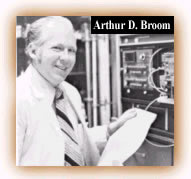 |
“We were all young turks, trying to carve out an academic career,” agrees Gibb. “It was kind of a bootstrap
operation.” Yet Wolf could see the outlines of excellence taking
form when he interviewed to be dean. He had been away from Utah for 15
years and had no intention of leaving his position at Ohio State University.
The Boston native had never ventured west of Chicago until he moved to
Salt Lake City for graduate school, and didn’t plan on returning.
“When my wife, Joan, and I drove to the corner of the Wasatch Range
in 1961, we looked over our shoulders and said, ‘These have been
good years, but we will never ever be back here again,’” says
Wolf. “I was here in the early years of the college. It was a very,
very different environment. The entire college consisted of three faculty
members and the dean, and eight or nine graduate students.”
During his interview, however, he says, “I realized the potential
was much greater than I’d thought. I decided it was a place that
had a very good chance of becoming one of the better colleges of pharmacy
in the United States.”
The possibility for collaborative research impressed Wolf, particularly
“the very special relationship that had developed between the College
of Pharmacy and the School of Medicine, because of Ewart and Lou.”
The late Louis S. Goodman, first chair of the medical school’s Department
of Pharmacology, had already co-authored the textbook still considered
“the blue bible” of pharmacology. In fact, that’s what
had drawn Wolf westward in the first place. The late Ewart W. Swinyard
PhD’47—Wolf ’s mentor—was Goodman’s first graduate
student. As the first faculty member in the pharmacy college when it was
established in 1946, Swinyard also had a joint appointment in the medical
school.
The two men influenced Gibb, as well. “That combination—Lou
Goodman and Ewart Swinyard—was very attractive to me. But I have
to admit, it was the quality of the Department of Pharmacology—not
to detract from the College of Pharmacy—that drew me,” says
Gibb of his interview for a job at the U.
The former Canadian had just finished a postdoc at the NIH and was impressed
with Swinyard’s leadership. “He maintained that research should
be the basis of any pharmacy education,” says Gibb. “Ewart really
made it the center of his administration, and it turned out to be a very
wise move.”
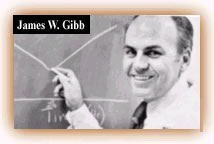 |
Broom might not have joined the U faculty were it not for the future
he saw in research. After working at Johns Hopkins University in Baltimore,
he found Salt Lake City “rustic, shall we say,” when he was
offered a one-year position to start up a lab in the new, and then rather
empty, L.S. Skaggs Hall. “The University was eyeballing all the space,”
recalls the medicinal chemist, who joined the faculty the next year. “Ewart
was the only person doing research, and he wanted to expand the capabilities.
“From that point, we had a nucleus of researchers and were able to
attract top students. With gifted people in the dean’s office, we
were able to build the college to what it is today”: 69 faculty members,
120 graduate students, and 117 undergraduates. A confirmed researcher—“I’ve
been funded by NIH and the American Cancer Society pretty much my whole
career”—Broom has managed to keep it in perspective. “As
Hal would remind us, the sign on the building doesn’t say ‘Skaggs
Hall of Research.’ It says ‘College of Pharmacy.’ Here,
the leadership has always recognized the importance of research while
maintaining the centrality
of the college.”
He attributes this balance to the way in which the college has, from the very beginning, recruited faculty members. “The expectation is that you will be a good researcher, publish and get funding, and, in the same breath, be a good teacher. We’re serious about it,” says Broom. “Research gets us recognized nationally, but it’s equally important that our people perform well in the classroom and communicate to students.”
No one in the history of the college has devoted more energy to teaching than Roll. He was elected an Outstanding Educator of America, received the college’s Distinguished Teaching Award twice, the ASUU Students’ Choice for Teaching Award twice, and the University’s Presidential Teaching Scholar Award. “Originally, I did some research, certainly not a whole lot,” says Roll. The Montana native knew he wanted an academic position after finishing his doctorate at the University of Washington. But an acute illness prevented him from interviewing anywhere. After he had spent one year as a research chemist in a public health lab in Florida, a position in the West opened up.
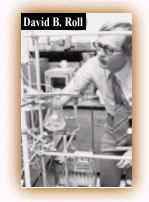 |
At the U, Roll’s talent soon was recognized. “I ended up with
a rather large teaching load,” he says, though it’s a phrase
he doesn’t like. “We always talk about ‘teaching loads’
but ‘research opportunities.’ There is a certain bias
in those terms. We live on research dollars—I understand all that.
But I don’t think we’re a kinder, gentler place for it.
“The whole trend we’re seeing in higher education today is a
lot more me, me, me; less us, less looking out for the good
of the whole endeavor. When we first came, there seemed to be time for
everyone to be concerned about what was happening to the college,”
says Roll. “When one of us had a success, why, that meant we all
got closer together. There wasn’t jealousy. We succeeded in different
ways at different times.”
“Collegiality is an important part of what we do in the college,”
agrees Broom. “It doesn’t mean we always get along swimmingly.
But we can always work together, even if we’re miffed.” He speaks
from experience. The college has undergone two major changes in the years
since 1976. First, Wolf reorganized the original two departments and created
five, four of which remain: medicinal chemistry, pharmaceutics and pharmaceutical
chemistry, pharmacology and toxicology (which absorbed the medical school’s
pharmacology department in 1986), and pharmacy practice.
“It was quite new, but wasn’t unique,”says Wolf of the
reorganization, which had been seconded by a consultant. The other change
is in the final stages of implementation. With the class of 2006, students
will graduate with a doctor of pharmacy degree, rather than a bachelor’s.
“It’s been a long-standing intellectual thrust of mine that
doctoral education is the only and appropriate degree for the practice
of pharmacy,” says Wolf, who chaired the National Commission to Implement
Change in Pharmacy Education for the AACP.
The U faculty voted to make the curricular change in 1988. However, “some
of us were kicking and struggling,” says Broom, who now admits, “Art
Broom was dead wrong. Hal moved us into the entry-level Pharm.D. educational
arena but kept the research ship afloat.”
Echoing Broom, Wolf notes, “Collegiality is the key to much of the
success that the college has enjoyed.
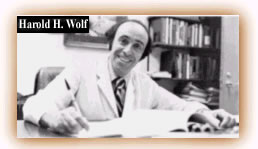 |
Competence is necessary, but it’s not enough. One of the things
that attracted me to come to the U originally was the level of collegiality
apparent at the entire health sciences center.”
In this group of faculty members, respect and admiration have also drawn
them together. “Hal was the perfect dean for the time,” says
Broom of his 67-year-old friend. “He’s a very funny guy and
one of the best speakers. I love to listen to him talk.”
Broom, 65, is “one of the sharpest, smartest people I’ve ever
met,” says Roll. “He wasn’t a pharmacist, but he was able
to come in and teach courses at levels people appreciated and found relevant.”
At 62, Roll is the self-described “bad jokester of the group. I love
bad puns.” Gibb, 69, is seen by his colleagues as “genuinely
one of the nicest people,” “a true gentleman,” and “a
very good scientist.”
Humor, too, has kept the friends together. These days, their jokes are
often about “ailing and failing body parts.” But there’s
always the black crow—which isn’t really a story about bad slides
as much as believing in, and pursuing, what you can’t always see:
the promise of greatness.
—Susan Sample is editor of the University’s Health Sciences
Report magazine.
